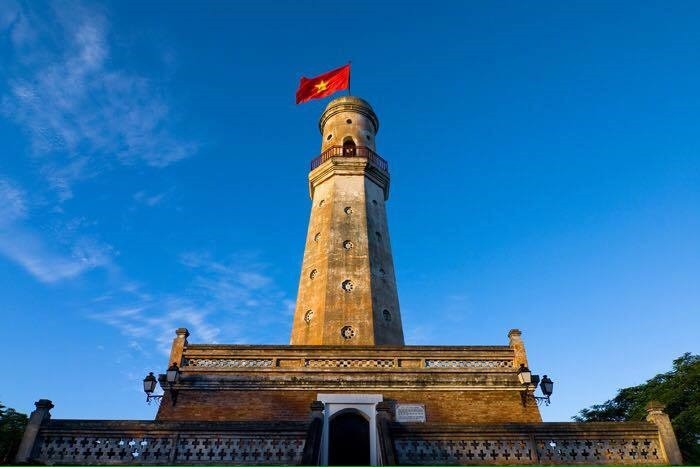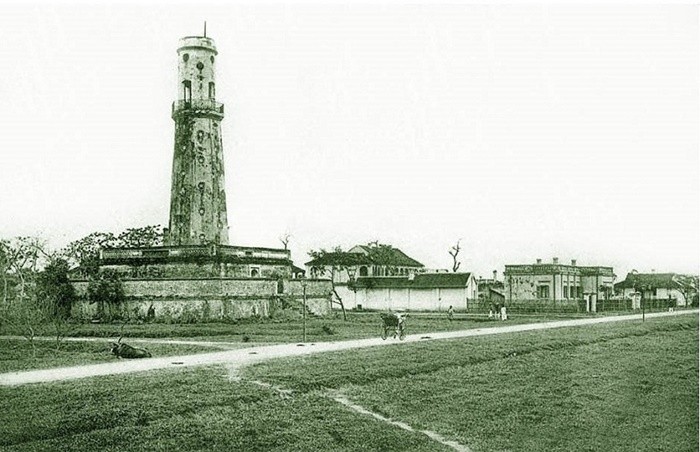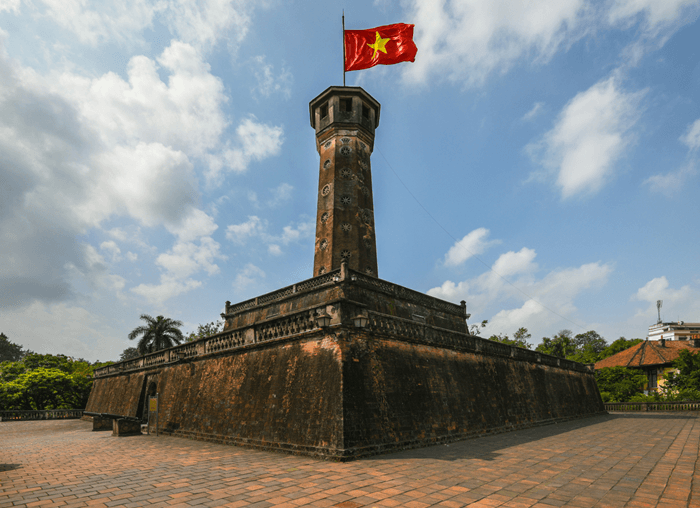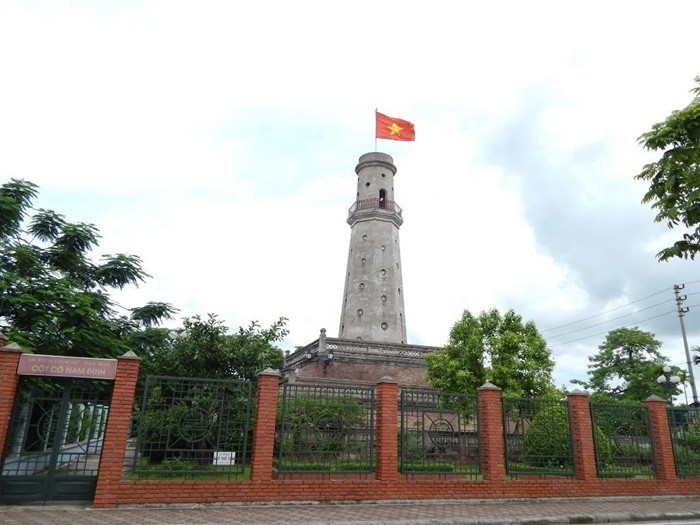Returning to the land of the masterpieces of Nam Dinh, visitors do not miss the Nam Dinh flagpole – a witness of the history along the years and the pride of the people here.
For the people of Thanh Nam, the image of the Nam Dinh flagpole has become a familiar symbol associated with the lives of the people here. Built in the early 19th century, through many historical ups and downs, Thanh Nam flagpole is still standing proudly against the blue sky. The image of a red flag with a yellow star fluttering on the roof is like a symbol of national heroism.
Visiting this relic, visitors not only feel the quiet, dignified and ancient beauty of the flagpole, but you will also feel the pure and gentle beauty interwoven with mossy stone steps traced in the trails. the ups and downs of time.
 Thanh Nam flagpole
Thanh Nam flagpole
Determine the coordinates of the Nam Dinh flagpole
Address: Located on To Hieu Street – Ngo Quyen Ward – Nam Dinh City
Nam Dinh flagpole ( Thanh Nam flagpole ) is also known as Thanh Nam flag tower. This is one of four flagpoles built at the beginning of the Nguyen Dynasty, including: Monuments of Hue Imperial Citadel (1807); Monument of Hanoi (1812); Bac Ninh citadel (1838). This monument is located in the south of the inner city, in front of Kinh Thien Palace is now Vong Cung Pagoda.
Going to Nam Dinh, going on To Hieu – Ngo Quyen street, visitors will admire the majestic beauty of Thanh Nam monument – an ancient architectural work of great historical and cultural value. And this is also a symbol of arousing love for the homeland, the country and pride in national sovereignty.
Thanh Nam flagpole and historical mark
According to many reference sources, Thanh Nam flag tower was built at the same time as Hanoi flagpole in 1812; In the 11th year of Gia Long, in the south of the inner city, about 100m from Vong Cung. After many restorations, in 1843, the Thanh Nam flagpole was completed.
The flagpole in Nam Dinh city is associated with many important historical landmarks:
– March 27, 1883: French warships from the Dao River bombarded the citadel. At the flagpole, at an altitude of 11m to the south, there is still a bullet hole in the back of 4cm, 6cm in diameter. During the period of secret activities, many cadres and Party members still used the flagpole as a place of communication and activities and a desk to direct the movement. In 1967, Nam Dinh was suspended fiercely by US aircraft. The top of the flagpole is the place where the aircraft observation team led by Comrade La Vinh Hao – self-defense textile factory commanded a long-distance mission.
– June 11, 1972: American aircraft crashed into Textile City. At 10:10 am, the American colonialists fired rockets and hit the flagpole area and collapsed the entire ancient structure. In 1997, the 43rd anniversary of the liberation of Nam Dinh city, the flagpole was restored to its original form.
Nearly 2 centuries have passed, Thanh Nam flagpole has witnessed many historical events and changes of the homeland and the country. This is an ancient architectural work of historical and cultural value, and it is also a symbol of arousing love for the homeland and a sense of pride in the process of protecting the right to independence, sovereignty and freedom. of the Fatherland.
Every year, this place welcomes hundreds of delegations to visit and remember the flagpole Queen. In 1962, Nam Dinh flagpole was recognized as a national historical-cultural relic by the Ministry of Culture and Information.
 Check-in at the flagpole
Check-in at the flagpole
How to go to Nam Dinh flagpole?
To move to Thanh Nam flagpole, visitors can travel in many ways such as by train, passenger car, limousine or private car, motorbike.
From Hanoi, if tourists go by bus, it will cost from 80,000k – 100,000k/ticket; If you go by train, there will be tickets ranging from 81,000 VND to 180,000 VND/ticket.
Note: For tourists in provinces as far away as the South, choosing to take the train to Nam Dinh or take a plane to Hanoi and then take a bus to Nam Dinh is the most optimal choice.
Discover the architecture of Thanh Nam monument
Nam Dinh flagpole started construction in Nhan Than year with the Gia Long 11 (1812) year, and completed in the year of the Rabbit – Thieu Tri 3 (1843). Today’s flagpole consists of 3 main parts: the base (the pedestal), the pole’s body (the tower’s body) and the gazebo (the gazebo). Thanh Nam monument is 23.84m high; located in the south of the ancient citadel, 100m from Vong Cung communal house.
The entire flagpole is located on 2 floors of pedestals, the square column gradually decreases from the bottom up. The bottom floor is square with each side 16.33m long and 2.4m high. The East and West sides of the 1st floor have 2 brick stairs with 10 steps leading to the 2nd floor, each side is 11.42m long and 3.1m high. The four sides of the pedestal are built with solid railings, with four doors.
 Old pictures of flagpoles
Old pictures of flagpoles
Flagpole yard
In the past, the flagpole yard was built into a ceremony yard, a square with a railing surrounded on four sides. The South placed 2 cannons; In the East, there is an incense burner to commemorate the martyrs and heroes who died in the two wars of resistance against the French to protect the Flagpole – Citadel in 1873 and 1883.
 Nam Dinh flagpole yard
Nam Dinh flagpole yard
Flagpole stand
The flagpole base includes 2 square pedestals; The upper pedestal is smaller than the lower pedestal. Around the outside of the two sides of the pedestal, railings are built to ensure the safety of visitors. The pedestal on each side is 16.33m long; 2.4m high. From the lower pedestal to the upper pedestal, stairs are built up and down. The pedestal on each side is 11.42m long; 3.1m high. The four sides of the pedestal are built with railings and have four doors.
On the second pedestal, there is a door to the body of the flagpole. On the East door frame, there are 2 words “Nhanh Huc”. The South door frame has 2 words “Huang Quang” in the direction of Duc Sang. The southern gate also has a stone stele engraved with Chinese characters “Ky Dai” and “Thieu trien trien phu quoc”. Under the pedestal, there is also a shrine to the Queen of Flagpoles – Princess Nguyen Thi Trinh, who died in the battle of the French invaders to capture and defeat Nam Dinh citadel on December 11, 1873.
 Flagpole stand
Flagpole stand
Flagpole body
The body of the flagpole is 12.65m, gradually shrinking upwards with 2 parts: the lower part is built in an octagonal cylinder with 2.2m each side, the upper part is built in a circle with a bottom diameter of 3.25m. In the body of the flagpole, there is a spiral staircase consisting of 54 steps going up to the watch tower, illuminated by 32 asterisk-shaped windows on 8 sides of the flagpole body.
The watchtower is built in a cylindrical shape with a balustrade, 4 arched doors and 8 small windows. From the watchtower, there is a small iron ladder leading to the top of the flagpole. At the top of the flagpole, visitors can zoom out to see the mountains, rivers, fields of Nam Dinh and 3 provinces of Thai Binh, Ninh Binh and Ha Nam.
 Flagpole body
Flagpole body
Fired brick material
Nam Dinh flagpole is built from old burnt brick material, dark red with the size of 0.3m x 0.15m x 0.07m. The square corners of the two pedestals are built with a type of brick with a beveled head of 450, while the angles at 1200 of the body of the octagonal pillar are built of separate bricks. Floor tiles size is 0.28m x 0.28m x 0.07m with black color.
 Flagpole made of baked bricks
Flagpole made of baked bricks
Note when visiting Thanh Nam flagpole
When visiting Nam Dinh radio station, visitors can pay attention to some of the following issues:
- You need to pay attention to the dress as well as dress neatly. Should wear sports shoes or flat shoes instead of high heels for easier and more convenient movement.
- When visiting Thanh Nam monument, remember to follow the general rules of the monument, avoid touching the artifacts, respect the common properties, speak softly, and do not litter indiscriminately.
- Be very careful when moving up the stairs; Especially for families who bring young children along, they should be careful because on rainy days, the steps are moldy and easy to slip.
Over 200 years, Nam Dinh flagpole has witnessed many historical events as well as the change of Thanh Nam land. And if you visit once, don’t forget to visit this historical architecture to better understand the glorious and heroic feats of the Vietnamese people in the resistance war against the invaders and defend the Fatherland.
Source: Collected internet.